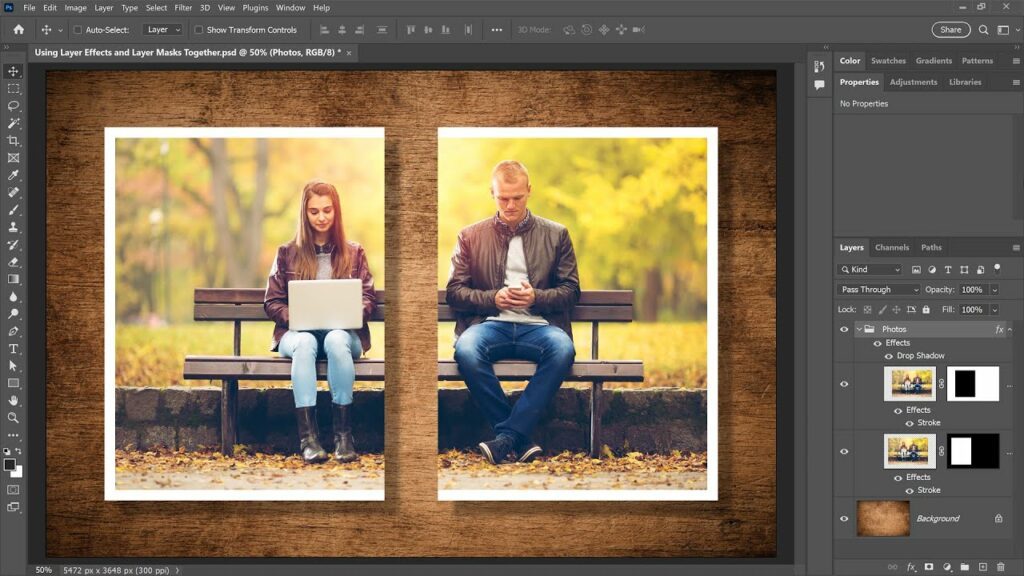Mastering Depth and Detail: A Comprehensive Guide on Using Layer Effects with Layer Masks in Photoshop
Adam.Smith February 12, 2024 0
Introduction:
Adobe Photoshop, a dynamic powerhouse in the world of graphic design, provides designers with a rich toolkit to elevate their creations. Among the versatile features at your disposal are Layer Effects and Layer Masks, two powerful elements that, when combined, offer unprecedented control over the depth, detail, and visual impact of your designs. This comprehensive guide aims to explore the symbiotic relationship between Layer Effects and Layer Masks in Photoshop, providing a step-by-step walkthrough to unlock their full potential. Whether you’re a seasoned designer or just starting your creative journey, mastering this fusion can take your designs to new heights.
I. Understanding Layer Effects:
A. Layer Styles:
- Layer Effects, also known as Layer Styles, are a set of non-destructive effects applied to layers.
- They include options like Drop Shadow, Inner Glow, Bevel & Emboss, and more.
B. Customization:
- Layer Effects are highly customizable, allowing designers to control intensity, color, and blending options.
- They add depth, texture, and visual interest to layers.
II. Exploring Layer Masks:
A. Layer Mask Basics:
- Layer Masks allow for selective visibility or transparency within a layer.
- White reveals, and black conceals – painting on a Layer Mask with shades of gray controls transparency.
B. Non-Destructive Editing:
- Layer Masks enable non-destructive editing, preserving the original content of the layer.
- They provide flexibility and control over the visibility of specific areas.
III. Combining Layer Effects and Layer Masks:
A. Applying Layer Effects:
- Select the layer to which you want to apply Layer Effects.
- Access the “fx” icon at the bottom of the Layers panel and choose the desired effect.
B. Adding Layer Masks:
- With the layer selected, click on the “Add Layer Mask” icon at the bottom of the Layers panel.
- This creates a Layer Mask linked to the layer.
IV. Using Layer Effects and Masks for Depth:
A. Drop Shadow:
- Apply a Drop Shadow Layer Effect for depth and dimension.
- Use a Layer Mask to control where the shadow is visible, blending seamlessly with the background.
B. Bevel & Emboss:
- Enhance the layer’s three-dimensional appearance with Bevel & Emboss.
- Fine-tune the effect by painting on the Layer Mask to control its application.
C. Inner Glow and Outer Glow:
- Add a subtle Inner Glow or Outer Glow for a soft halo effect.
- Refine the glow’s visibility using a Layer Mask for a natural transition.
D. Stroke:
- Apply a Stroke for emphasis around the layer’s edges.
- Use a Layer Mask to selectively reveal or hide parts of the stroke for a polished look.
V. Creating Visual Interest with Gradient Overlays:
A. Gradient Overlay:
- Apply a Gradient Overlay to introduce color transitions.
- Use a Layer Mask to customize where the gradient is most prominent.
B. Multi-Layered Effects:
- Combine multiple Layer Effects with Layer Masks for intricate visual compositions.
- Experiment with stacking effects and masks to achieve unique results.
VI. Advanced Techniques for Precision:
A. Clipping Masks:
- Use Clipping Masks to limit the visibility of Layer Effects to specific layers.
- This ensures that effects only affect the desired elements within the design.
B. Grouping Layers:
- Group layers and apply Layer Effects to the group for cohesive design elements.
- Utilize Layer Masks within groups for refined control.
VII. Real-World Examples and Applications:
A. Text Effects:
- Apply Layer Effects and Masks to text layers for captivating typography.
- Achieve effects like neon glow, metallic sheen, or embossed lettering.
B. Image Manipulation:
- Use Layer Effects and Masks for creative image manipulation.
- Add a vintage glow, surreal atmosphere, or selective focus to your images.
VIII. Troubleshooting and Tips:
A. Layer Order:
- Pay attention to the layer order when applying Layer Effects and Masks.
- The order can impact the appearance and interaction of effects.
B. Opacity and Fill:
- Adjust the layer’s overall opacity and fill for subtle or transparent effects.
- Find the balance that complements your design.
IX. Conclusion: Elevating Designs with Precision and Style
In conclusion, the marriage of Layer Effects and Layer Masks in Photoshop is a marriage of precision and style, empowering designers to create visually stunning and nuanced compositions. This comprehensive guide has provided a roadmap for harnessing the synergy between these elements, from applying effects to mastering masks and achieving depth and detail in your designs. As you integrate these techniques into your creative toolkit, let experimentation and exploration guide your journey. Whether you’re enhancing text, manipulating images, or crafting intricate visual effects, the fusion of Layer Effects and Masks in Photoshop offers a realm of possibilities to elevate your designs to new heights.




